While Billie Eilish has reinvented pop with her hushed SoundCloud rap menace, creepy ASMR intimacy and chipper show tune melodies, there’s also something reassuringly comforting about her: as a teenage pop star, she has fulfilled her proper duty by confusing the hell out of adults. It’s largely down to her aesthetic: a funhouse Fred Durst; a one-woman model for the combined wares of Camden Market. Critics have tried to make sense of it, but when editorials praised Eilish’s “total lack of sexualisation”, she denounced them for “slut-shaming” her peers. “I don’t like that there’s this weird new world of supporting me by shaming people that may not want to dress like me.”
To Gen Z’s Eilish, not yet 18, it is a weird new world. She and her millennial peers have grown up in a decade in which pop’s good girl/bad girl binary has collapsed into the moral void that once upheld it, resulting in a generation of young female stars savvy to how the expectation to be “respectable” and conform to adult ideas of how a role model for young fans should act – by an industry not known for its moral backbone – is a con. “It’s a lot harder to treat women the way they were treated in the 90s now, because you can get called out so easily on social media,” Fiona Apple – who knows about the simultaneous sexualisation and dismissal of young female musicians – said recently. “If somebody does something shitty nowadays, a 17-year-old singer can get on their social media and say, ‘Look what this fucker did! It’s fucked up.’”

Female musicians have been subject to conflicting moral standards for longer than Eilish has been alive. Madonna, Janet Jackson and TLC knew them well – but the concept of the pop “role model”, expected to set an example to kids, solidified when the Spice Girls became the first female act to be marketed at children. In the 70s and 80s, idols such as David Cassidy primed girls for a monogamous future. By comparison, the Spice Girls were lunatics conquering the asylum. But, given their fans’ youth – and the sponsors that used the band to reach them – they also had a duty of responsibility. Their real lives – the all-nighters and eating disorders – were hidden so effectively that Eilish, born in 2001, thought the band was made up, actors playing the roles of the group in Spiceworld: The Movie.
In the late 90s, kid-pop became an industry unto itself: Smash Hits and Top of the Pops magazine pitched younger; CD:UK and America’s TRL aimed at Saturday-morning and after-school audiences; Simons Fuller and Cowell built empires. The scrappy Spice Girls preceded the cyborgian Britney, who was a far sleeker enterprise – until she wasn’t. She was pitched as a virgin: cruel branding that invited media prurience and set a time bomb counting down towards her inevitable downfall. Britney’s 2007 breakdown revealed the cost of living as a virtuous cypher and being expected to repress her womanhood to sell to American prudes. Her shaved head and aborted stints in rehab prompted industry handwringing, and so an illusion of the music business offering greater freedom and care for pop’s girls emerged in her wake.
Major labels abandoned the traditional two-albums-in bad-girl turn (a la Christina Aguilera’s Stripped). Social media-born artists such as Lily Allen and Kate Nash were swept into the system and framed as the gobby antithesis to their manicured pop peers – until their resistance to exactly the same kind of manipulation saw them cast aside. And if Kesha, Lady Gaga or Amy Winehouse burned out, their visible excesses would distract from any behind-the-scenes exploitation, inviting spectators to imagine that they brought it on themselves.
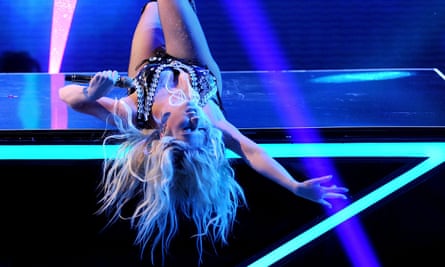
At the dawn of the 2010s, social media surpassed its teen origins to become an adult concern, and an earnest fourth wave of activists brought feminism back to the mainstream. Like a rescued hatchling, it was in a pathetic state to begin with – dominated by white voices that tediously wondered whether anything a woman did was automatically feminist. Is brushing your teeth with Jack Daniel’s feminist? Are meat dresses feminist? Is drunkenly stumbling through Camden feminist? Are butt implants feminist?
Pop culture became the natural test site for these ideas – especially music, where a new wave of artists challenged this nascent, often misguided idealism. Kesha reclaimed the hard-partying values of rock’s men to embody a generation’s despair at seeing their futures obliterated by the recession. Lady Gaga questioned gender itself, as one writer in this paper put it, “re-queering a mainstream that had fallen back into heteronormative mundanity”. In a career-making verse on Kanye West’s Monster, Nicki Minaj annihilated her male peers and gloried in her sexualisation. MIA, infuriated by America’s hypocritical propriety, flipped off the Super Bowl and proved her point by incurring a $16.5m fine.
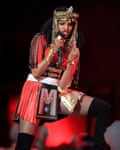
As a former Disney star, Miley Cyrus stepped the furthest out of bounds. In 2008, aged 15, she had posed in a sheet for Vanity Fair. “MILEY’S SHAME,” screamed the New York Post. She apologised to her fans, “who I care so deeply about”. But in 2013, she torched her child-star image by writhing in her knickers on a wrecking ball, twerking against Robin Thicke, being flagrant about her drug use, appropriating African American culture while perpetuating racist stereotypes.
Cyrus’s 2013 transformation bore the hallmarks of a breakdown – especially witnessed two years after the death of Amy Winehouse, who was then perceived as a victim of her own self-destruction. But Cyrus was largely intentional about her work (if, then, ignorant of her racism). She had waited until she was no longer employed by Disney to express herself. Earlier in her career, she said, she struggled to watch her peers. “I was so jealous of what everyone else got to do, because I didn’t get to truly be myself yet.” Despite apparently smoking massive amounts of weed herself, she didn’t want to tell kids to copy her. But she knew the power she offered her peers such as Ariana Grande, who that year left Nickelodeon to release her debut album. “I’m like, ‘Walk out with me right now and get this picture, and this will be the best thing that happens to you, because just you associating with me makes you a little less sweet.’”
Pop did get a little less sweet. Sia and Tove Lo sang brazenly about using drugs to mask pain. Icona Pop’s I Love It reigned (“I crashed my car into a bridge / I watched and let it burn”) thanks to its inclusion on the soundtrack of Lena Dunham’s Girls. With its aimless characters and their ugly behaviour, the show mirrored pop’s retreat from aspirational sheen, and the culture’s growing obsession with “messy” women and “strong female characters”: flawed attempts to create new archetypes that rejected the expectation of girls behaving nicely.

A new cohort of young female and non-binary critics shifted the discussion around music: in 2015, when the documentary Amy was released, they questioned how Winehouse was perceived in death compared to Kurt Cobain. They also pushed aside the virgin/whore rivalries of old. In an earlier era, Beyoncé and Lana Del Rey might have been fashioned into nemeses, one sexualised and powerful, the other gothic and demure. Instead, their respective mid-decade self-mythologising showed that female musicians could be pop’s auteurs, not just the men in the wings.
Beyoncé’s self-titled 2013 album was an explicit rejection of her role-model status. She was 15 when Destiny’s Child released their debut album. “But now I’m in my 30s and those children that grew up listening to me have grown up,” she said in a behind-the-scenes video. The responsibility she felt to them “stifled” her. “I felt like ... I could not express everything … I feel like I’ve earned the right to be me and express any and every side of myself.”
It was the first of her albums to reveal the breadth of her inner life – the coexisting kinks, triumphs and insecurities, showing the complexity of black womanhood. The critic Soraya Nadia McDonald wrote: “Mixed in with songs about insecurity, grief, protest and the love she has for her child, Beyoncé manages to present her sexuality as a normal part of her life that deserves celebration.” “It doesn’t make you a bad mother. It doesn’t make black people look bad, and it doesn’t make you a bad feminist, either.” When Beyoncé emblazoned “FEMINIST” on stage at the 2014 MTV VMAs, she helped reclaim the word from middle-class white discourse.
Like Beyoncé, Del Rey countered the idea that female pop stars were major-label puppets. She had struggled to make it as an indie artist but found a home at Polydor – a detail that caused detractors to question her authenticity. Her shaky debut SNL performance revealed the flaw in their thinking: if she was manufactured, wouldn’t she have been better drilled? Her project was potent, but startlingly unrefined. More intriguingly, she opposed fast-calcifying ideas about how feminist art should look: Del Rey’s lyrics revelled in submission and violence, in thrall to bad guys and glamour. It wasn’t feminist to want these things; but nor was it feminist to insist on the suppression of desire in the name of shiny empowerment.
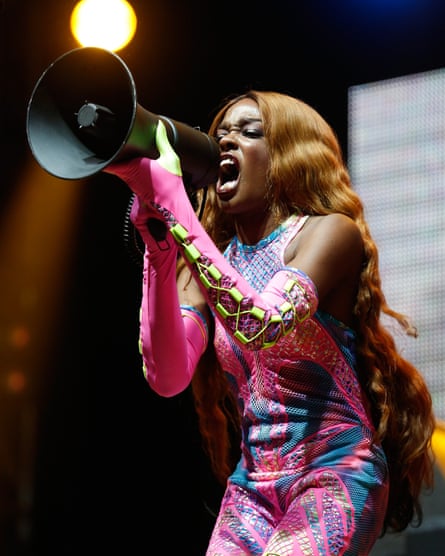
Del Rey’s lusts and designs were her own – pure female gaze – a hallmark of the defiant female pop stars to come. Rihanna said she was “completely not” a role model, a point driven home by the viscerally violent video for Bitch Better Have My Money. Lauren Mayberry of Scottish trio Chvrches refused to be singled out from her male bandmates and wrote searingly about the misogyny she faced online. Janelle Monáe and Solange rubbished the idea that R&B was the only lane open to young black women.
They started revealing their business conflicts. In 2013, 21-year-old Sky Ferreira finally released her debut, six years after signing a $1m record deal. She was transparent about her paradoxical treatment: “They worked me to death, but when I wanted to input anything, it was like, ‘You’re a child, you don’t know what you’re talking about.’” When Capitol pulled funding for the album, she financed its completion: it was widely named an album of the year. Facing similar frustrations, rapper Angel Haze leaked her 2013 album, Dirty Gold, and Azealia Banks wasted no opportunity to expose industry machinations.
The rise of Tumblr and SoundCloud put young artists in control of their own artistic identities, forging authentic fan relationships that labels couldn’t afford to mess with. Lorde was signed age 12, but her manager knew he had to follow her lead because she knew her audience better than he did. Halsey was already Tumblr-famous for her covers, hair colours and candour about her bisexuality and bipolar diagnosis when she posted her first original song in 2014. It received so much attention that the 19-year-old – who described herself as an “inconvenient woman” for everything she represented – signed to major label Astralwerks the following evening.
A new type of fan arrived with them. The illusion of intimacy led to greater emotional investment – and with it, an expectation of accountability. Social media was being used to arbitrate social justice issues, giving long overdue platforms to marginalised voices, and establishing far more complex moral standards for pop stars than the executives who shilled Britney’s virginity could ever have imagined. In 2013, Your Fav Is Problematic began to highlight stars’ missteps: among Halsey’s 11 infractions were “sexualising Japanese culture” and allegedly falsifying her story about being “homeless”.
Musicians, particularly of an older guard, were unprepared. Lily Allen’s comeback single Hard Out Here, released in late 2013, satirised the impossible aesthetic standards expected of female musicians – a bold message undermined by the racist stereotypes she invoked to make her point: “Don’t need to shake my arse for you ’cause I’ve got a brain,” she sang, while black and Asian leotard-clad dancers twerked around her in the video. The backlash was swift. There was the sense of a balance tipping.

Over the decade, female pop stars steadily self-determined beyond the old limited archetypes. But the most dramatic identity shifts were still a product of adversity, women battling for control.
In 2015, Ariana Grande provoked mild outcry when she got caught licking a doughnut she hadn’t paid for and declaring: “I hate America.” Two years later, a suicide bomber attacked her concert at Manchester Arena, leaving 22 dead. She went home to Florida in the aftermath, then returned to stage benefit concert One Love Manchester. A victim’s mother asked Grande to perform her raunchiest hits after the Daily Mail implied that the bomber had targeted the concert because of her sexualised aesthetic. So she did. By prioritising her mental health and refusing to let terrorists suppress girls’ joy and sexuality, she set a powerful example for fans that ran counter to the moralising of commentators such as Piers Morgan.
Grande appeared to emerge from this tragedy – and the death of ex-boyfriend Mac Miller – with a renewed sense of what was important, and what really was not. Her next album, Sweetener, defiantly reclaimed happiness from trauma; she swiftly released another, Thank U, Next, abandoning traditional pop release patterns to work with a rapper’s spontaneity. “I just want to fucking talk to my fans and sing and write music and drop it the way these boys do,” she said.
Kesha had helped instigate this decade of greater freedom for female musicians – or so it seemed until October 2014, when she sued producer Dr Luke, making allegations including sexual assault. (In spring 2016, a judge dismissed the case; Luke denies all allegations and is suing Kesha for defamation.) She claimed she was told she had to be “fun”, an image that Luke’s label intended to capitalise on, revealing how revelry could be just as confining as its prim counterpart. In 2017, she released Rainbow, her first album in five years. Addressing her trauma, it got the best reviews of her career – a response that also seemed to reveal something about the most digestible way for a female artist to exist. But her forthcoming album, High Road, pointedly returns to the recklessness of her first two records. “I don’t feel as if I’m beholden to be a tragedy just because I’ve gone through something that was tragic,” she said.
Taylor Swift’s refusal to endorse a candidate in the 2016 election, and the fallout from a spat with Kanye West, saw her shred her image of nice-girl relatability with her 2017 heel-turn, Reputation. But she rebelled more meaningfully when she leveraged her profile to expose the music industry, alerting the public to otherwise opaque matters of ownership and compensation. She joined independent labels in the fight to make Apple Music pay artists for the free trial period it offered consumers. Earlier this year, she despaired at her former label, Big Machine, being bought – and the master recordings to her first six albums with it – by nemesis Scooter Braun, an option she claimed she was denied. Now signed to Universal, and the owner of her masters going forward, she hoped young musicians might learn from her “about how to better protect themselves in a negotiation”, she wrote. “You deserve to own the art you make.”
Swift’s formative politesse came from country music, an industry that emphasises deference to power and traditional gender roles. In 2015, consultant Keith Hill – using a bizarre metaphor about salad – admitted that radio sidelined female musicians: they were then subject to endless questions about tomatogate, as if they had the power to fix it. But that blatant industry disregard freed female country artists to shuck off obligation and make whatever music they wanted. In recent years, Miranda Lambert, Ashley McBryde, Brandy Clark, Kacey Musgraves, Ashley Monroe, Maren Morris, Brandi Carlile and Margo Price have all creatively outstripped their male peers.

Their situation resonates beyond country: greater personal freedoms for female musicians haven’t equated to greater commercial success. Just because a wave of female pop acts have refused old industry ideals, that doesn’t mean control is consigned to the past. There will be young women enduring coercive music industry situations right now – whether manipulation or more serious abuse. Some may never meet those impossible standards, and fail to launch. Others may quietly endure years of repression before potentially finding their voice. There are high-profile female pop acts working today who control their work yet are still subject to grinding suggestions that they change to meet market demands, and noisy women from this decade who have been sidelined. The tropes of the self-actualised female pop star are so established that labels know how to reverse engineer “real” pop girls beholden to a script.
But the emergence of a more holistic female star will make it harder for labels to shill substitutes. Their emotional openness has destroyed the stigma around mental health that was used to diminish female musicians as “mad” divas. Charli XCX said she would never have betrayed her vulnerabilities when she was starting out in her teens. “If I’m emotionally vulnerable,” she thought, “people won’t take me seriously … Now I just don’t care.” Robyn spent eight years following up her most successful record because she needed time to grieve and unpick the impact of her own teen stardom. Britney – who in 1999 told Rolling Stone, “I have no feelings at all” – this year cancelled her Las Vegas residency to prioritise her mental health.
They’ve relentlessly countered the male gaze. Chris refused to simplify queerness for the mainstream; Kim Petras stood for “trans joy”; Rihanna challenged the idea of skinny as aspirational by creating inclusive fashion lines and candidly discussing her own shape. “Just me existing is revolutionary”, Lizzo has said, while Cardi B refused to let anyone use her past as a stripper undermine her legitimacy as a powerful political voice.
Where unthinking messiness was valorised at the start of the decade, now imperfection only gets a pass as long as nobody else is getting hurt. This summer, Miley, now 26, apologised for the racial insensitivity of her Wrecking Ball era. Soon after, she posted striking tweets in response to rumours of her cheating on her husband. She admitted to having been hedonistic and unprofessional in her youth. But she swore she hadn’t cheated in her marriage. “I’ve grown up in front of you, but the bottom line is, I HAVE GROWN UP,” she wrote. (To a degree – not long after, she found herself called out again when she implied that queerness is a choice.)
In their fallibility and resistance to commodification, the women who have defined this decade in pop look a lot more like role models than the corporate innocents sold to girls in the early millennium. They’re still learning, working with what they’ve got rather than submitting to what they’re told. “I don’t know what it feels like not to be a teenager,” Billie Eilish said recently. “But kids know more than adults.”
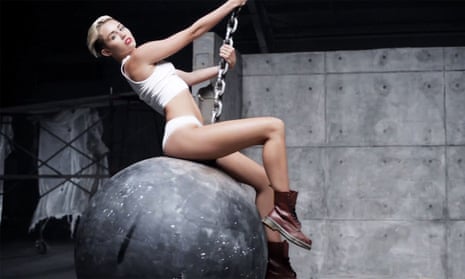








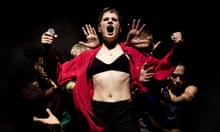

Comments (…)
Sign in or create your Guardian account to join the discussion